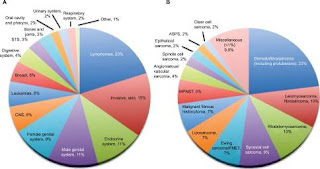Non-Rhabdomyosarcoma Soft Tissue Sarcoma (NRSTS) in Pediatric and Young Adult Patients
Soft tissue sarcomas, the fifth most common solid tumors in children, are relatively rare and account for about 6-7% of all childhood malignancies. About half of these tumors are rhabdomyosarcomas, and nonrhabdomyosarcoma soft tissue sarcomas (NRSTSs) account for the remainder (ie, about 4% of childhood malignancies).
NRSTSs are heterogeneous tumors that have varied biology and histology. The most common types in the pediatric population include fibrosarcoma, synovial cell sarcoma, fibrosarcoma, and malignant peripheral nerve sheath tumor. Other histologic types include hemangiopericytoma, alveolar soft part sarcoma, leiomyosarcoma, liposarcoma, epithelioid sarcoma, and desmoplastic small round cell tumor.
Childhood NRSTs are not well studied. Because soft tissue sarcomas are most common in adults, many treatment modalities are extrapolated from experiences in adult patients. However, many pediatric tumors differ from their adult counterparts in terms of clinical behaviors and outcomes. The prognoses of infants and young children with NRSTSs tend to be better than those of adolescents and adults with similar diagnoses.
Summary of results of targeted therapies in STS
| Class of drugs | Drug studied | Phases | Main results | References |
|---|---|---|---|---|
| TKI | Imatinib | II | Response in GIST, not in other histologies | 69,70 |
| Dasatinib | II | Response in undifferentiated pleomorphic sarcoma, currently being studied in more indolent types of STS | 71 | |
| Semaxinib | II | No significant anti-STS activity | 75 | |
| Pazopanib | II and III | Approved by the US FDA for the treatment of STS as second- line treatment. Pediatric and adult trials ongoing | 76,77 | |
| Regorafenib | II | Improved OS and PFS in LMS and improved PFS in other sarcomas | 86 | |
| Sunitinib | I and II | Activity in ASPS | 92–94 | |
| Cediranib | I/II | Activity in ASPS | 97 | |
| Vandetanib, gafetinib, and erlotinib | Preclinical and early clinical | Appeared promising in STS, but no conclusive studies yet | 100–102 | |
| Sorafenib | II | No objective responses | 105 | |
| Tivozanib | II | Response in metastatic and nonresectable STS (median follow-up 5.5 months) | 106 | |
| mTOR inhibitors | Temsirolimus | I | Tolerable in combination with chemotherapy or other targeted agents. Phase II study results pending | 108,109 |
| Sirolimus | II | In combination with cyclophosphamide or pazopanib some patients with PR or SD | 110,118 | |
| Everolimus | I and II | Investigated as monotherapy and in combination with figitumumab, or imatinib without RECIST response | 115–117 | |
| Other pathways | Histone deacetylase inhibitors; multiple agents | I and II | SB939, abexinostat with or without doxorubicin, vorinostat with bortezomib: tolerable and indication of potential clinical benefit; panobinostat: 36% SDs and no CRs or PRs. Preclinical data encouraging | 122–124,126,128,129 |
| Heat-shock protein 90 inhibitors; multiple agents | I | Retaspimycin hydrochloride: SD (60% at 6 weeks and 18% at 12 weeks). AAG tolerable in children. Ganetespib with sirolimus under investigation | 135,137 | |
| SINE | I preclinical | Tolerable, preliminary evidence of activity | 139,141 | |
| Immunotherapy | IGF-1R; multiple agents | I and II | Promising preclinically, but no consistent benefit in Phase II trials. Currently no further clinical studies | 113,143–148 |
| Bevacizumab | I | Alone and in combination with several traditional chemotherapeutics tolerable but clinical benefit unclear | 35,150,151 | |
| Olaratumab | I/II | In combination with doxorubicin, improved PFS and OS, but mostly older adults | 154 | |
| Ipilimumab | Pilot | Stopped early due to low accrual | 156 | |
| Checkpoint inhibition | Anti-PD-1 therapy promising in several solid tumors. First clinical trial in STS currently ongoing. Additional molecules targeting LAG2, Tim3, and BTLA4 emerging | |||
| Tumor vaccines; multiple targets | I | Vaccine against SS18, GD2, GD3, and NY-ESO showed antibody induction. Phase II clinical data pending | 170,171,173,174 | |
| Autologous T cell transfer (NY-ESO T cell receptor) | I | In synovial sarcoma promising (four out of six with response). Follow-up study currently ongoing | 176 | |
| CAR T cells | Mostly tested in hematologic malignancies and some bone sarcomas, but potentially promising modality especially in combination with immune-modulatory therapeutics |

Comments
Post a Comment